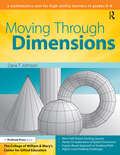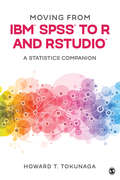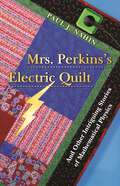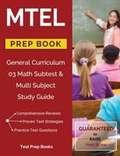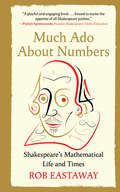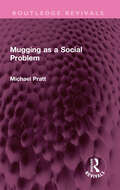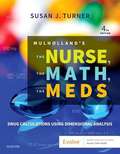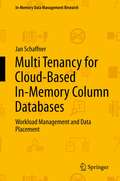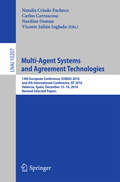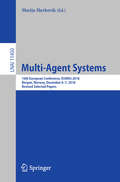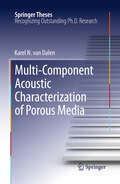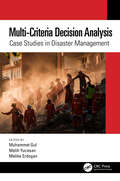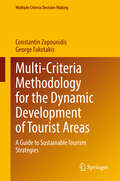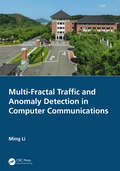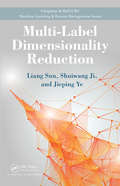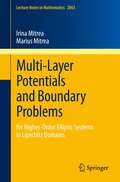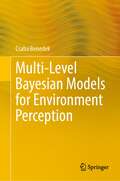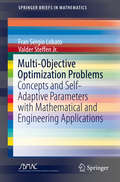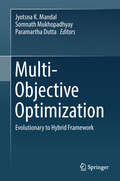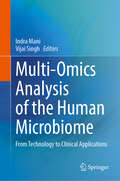- Table View
- List View
Moving Straight Ahead: Linear Relationships
by Glenda Lappan James T. Fey Susan N. Friel Elizabeth Difanis PhillipsNIMAC-sourced textbook
Moving Straight Ahead: Linear Relationships (Connected Mathematics)
by Glenda Lappan James T. Fey Susan N. Friel Elizabeth Difanis PhillipsThe contents of this book include: Moving Straight Ahead, Linear Relationships, Walking Rates, Exploring Linear Relationships with Graphs and Tables, Solving Equations, Exploring Slope: Connecting Rates and Ratios, English/Spanish Glossary, etc.
Moving Straight Ahead: Linear Relationships (Texas)
by Inc. Glenda Lappan James T. Fey William M. Fitzgerald Susan N. Friel Elizabeth Difanis Phillips WestWordsNIMAC-sourced textbook
Moving Through Dimensions: A Mathematics Unit for High Ability Learners in Grades 6-8
by Clg Of William And Mary/Ctr Gift EdMoving Through Dimensions approaches spatial reasoning through one-dimensional, two-dimensional, and three-dimensional tasks designed for students in the middle school grades. The unit also asks students to explore the transition between dimensions and representations of three-dimensional objects in two dimensions. This book includes pre- and postassessments, multiple reproducible materials, and lessons based on NCTM standards.Moving Through Dimensions was developed by the Center for Gifted Education at The College of William and Mary to offer advanced curriculum supported by years of research. The Center's materials have received national recognition from the United States Department of Education and the National Association for Gifted Children, and they are widely used both nationally and internationally.Each of the books in this series offers curriculum that focuses on advanced content and higher level processes. The science units contain simulations of real-world problems, and students experience the work of real science by using data-handling skills, analyzing information, and evaluating results. The mathematics units provide sophisticated ideas and concepts, challenging extensions, higher order thinking skills, and opportunities for student exploration based on interest. These materials are a must for any teacher seeking to challenge and engage learners and increase achievement.Grades 6-8
Moving from IBM® SPSS® to R and RStudio®: A Statistics Companion
by Howard T. TokunagaAre you a researcher or instructor who has been wanting to learn R and RStudio®, but you don′t know where to begin? Do you want to be able to perform all the same functions you use in IBM® SPSS® in R? Is your license to IBM® SPSS® expiring, or are you looking to provide your students guidance to a freely-available statistical software program? Moving from IBM® SPSS® to R and RStudio®: A Statistics Companion is a concise and easy-to-read guide for users who want to know learn how to perform statistical calculations in R. Brief chapters start with a step-by-step introduction to R and RStudio, offering basic installation information and a summary of the differences. Subsequent chapters walk through differences between SPSS and R, in terms of data files, concepts, and structure. Detailed examples provide walk-throughs for different types of data conversions and transformations and their equivalent in R. Helpful and comprehensive appendices provide tables of each statistical transformation in R with its equivalent in SPSS and show what, if any, differences in assumptions factor to into each function. Statistical tests from t-tests to ANOVA through three-factor ANOVA and multiple regression and chi-square are covered in detail, showing each step in the process for both programs. By focusing just on R and eschewing detailed conversations about statistics, this brief guide gives adept SPSS® users just the information they need to transition their data analyses from SPSS to R.
Moving from IBM® SPSS® to R and RStudio®: A Statistics Companion
by Howard T. TokunagaAre you a researcher or instructor who has been wanting to learn R and RStudio®, but you don′t know where to begin? Do you want to be able to perform all the same functions you use in IBM® SPSS® in R? Is your license to IBM® SPSS® expiring, or are you looking to provide your students guidance to a freely-available statistical software program? Moving from IBM® SPSS® to R and RStudio®: A Statistics Companion is a concise and easy-to-read guide for users who want to know learn how to perform statistical calculations in R. Brief chapters start with a step-by-step introduction to R and RStudio, offering basic installation information and a summary of the differences. Subsequent chapters walk through differences between SPSS and R, in terms of data files, concepts, and structure. Detailed examples provide walk-throughs for different types of data conversions and transformations and their equivalent in R. Helpful and comprehensive appendices provide tables of each statistical transformation in R with its equivalent in SPSS and show what, if any, differences in assumptions factor to into each function. Statistical tests from t-tests to ANOVA through three-factor ANOVA and multiple regression and chi-square are covered in detail, showing each step in the process for both programs. By focusing just on R and eschewing detailed conversations about statistics, this brief guide gives adept SPSS® users just the information they need to transition their data analyses from SPSS to R.
Mrs. Perkins's Electric Quilt: And Other Intriguing Stories of Mathematical Physics
by Paul J. NahinAn incomparable collection of stimulating math puzzles from bestselling author Paul NahinWhat does quilting have to do with electric circuit theory? The answer is just one of the fascinating ways that best-selling popular math writer Paul Nahin illustrates the deep interplay of math and physics in the world around us in his latest book of challenging mathematical puzzles, Mrs. Perkins's Electric Quilt. With his trademark combination of intriguing mathematical problems and the historical anecdotes surrounding them, Nahin invites readers on an exciting and informative exploration of some of the many ways math and physics combine to create something vastly more powerful, useful, and interesting than either is by itself.In a series of brief and largely self-contained chapters, Nahin discusses a wide range of topics in which math and physics are mutually dependent and mutually illuminating, from Newtonian gravity and Newton's laws of mechanics to ballistics, air drag, and electricity. The mathematical subjects range from algebra, trigonometry, geometry, and calculus to differential equations, Fourier series, and theoretical and Monte Carlo probability. Each chapter includes problems—some three dozen in all—that challenge readers to try their hand at applying what they have learned. Just as in his other books of mathematical puzzles, Nahin discusses the historical background of each problem, gives many examples, includes MATLAB codes, and provides complete and detailed solutions at the end.Mrs. Perkins's Electric Quilt will appeal to students interested in new math and physics applications, teachers looking for unusual examples to use in class—and anyone who enjoys popular math books.
Mtel General Curriculum 03 Math Subtest & Multi Subject Study Guide Prep Book
by Mtel Curriculum Prep TeamEach section of the test has a comprehensive review created by Test Prep Books that goes into detail to cover all of the content likely to appear on the general curriculum MTEL test. The Test Prep Books MTEL general curriculum practice test questions are each followed by detailed answer explanations. If you miss a question, it’s important that you are able to understand the nature of your mistake and how to avoid making it again in the future. The answer explanations will help you to learn from your mistakes and overcome them. Understanding the latest test-taking strategies is essential to preparing you for what you will expect on the exam. A test taker has to not only understand the material that is being covered on the test, but also must be familiar with the strategies that are necessary to properly utilize the time provided and get through the test without making any avoidable errors. Test Prep Books has drilled down the top test-taking tips for you to know. Anyone planning to take this exam should take advantage of the MTEL review material, practice test questions, and test-taking strategies contained in this Test Prep Books study guide.
Much Ado About Numbers: Shakespeare's Mathematical Life and Times
by Rob EastawayOpen a new portal into Shakespeare’s words—and his Renaissance life—with math and numbers as your key. Shakespeare’s era was abuzz with mathematical progress, from the new concept of “zero” to Galileo’s redraft of the heavens. Now, Rob Eastaway uncovers the many surprising ways math shaped Shakespeare’s plays—and his world—touring astronomy, code-breaking, color theory, navigation, music, sports, and more. How reliable was a pocket sundial? Was math illusionist John Dee the real-life Prospero? How long was a Scottish mile, and what could you buy for a groat? Do Jupiter’s moons have a cameo in Cymbeline? How did ordinary people use numbers day to day? And might Shakespeare have tried that game-changing invention—the pencil? Full of delights for devotees of both Tudor history and the Bard, Much Ado About Numbers is proof that the arts and sciences have always danced together.
Mugging as a Social Problem (Routledge Revivals)
by Michael PrattFirst published in 1980, Mugging as a Social Problem sets out to remedy the deficiency of serious research on mugging. The work is based on a random sample of over 1000 muggings which occurred within the Metropolitan Police District in the mid-1970s, and the author analyses the results not only in absolute and comparative terms but also against a background of social determinants such as ecology, deprivation and race. Dr. Pratt’s long-term solution is not novel: an all-round improvement in housing, employment and social conditions will eventually remove the circumstances which create muggers; but there are steps, he suggests, which can be taken in the short term to stop mugging by reducing opportunity. However, before any effective measures can be introduced, more facts are needed about the background, motives and methods of the typical mugger: it is just such facts that this study sets out to provide. This book will be of interest to students of sociology, law, urban studies and criminology.
Mulholland's The Nurse, The Math, The Meds: Drug Calculations Using Dimensional Analysis
by Susan TurnerMulholland’s The Nurse, The Math, The Meds, 4th Edition helps you overcome any math anxiety you may have by clearly explaining how to use dimensional analysis to minimize drug calculation errors. It shows how to analyze and set up problems, estimate a reasonable answer, and then evaluate the answer for accuracy. But first, a review of basic math ensures that you remember essential math skills. Updated by nursing educator Susan Turner, this edition includes plenty of practice exercises to help you understand and master each aspect of dimensional analysis.
Multi Tenancy for Cloud-Based In-Memory Column Databases: Workload Management and Data Placement
by Jan SchaffnerWith the proliferation of Software-as-a-Service (SaaS) offerings, it is becoming increasingly important for individual SaaS providers to operate their services at a low cost. This book investigates SaaS from the perspective of the provider and shows how operational costs can be reduced by using "multi tenancy," a technique for consolidating a large number of customers onto a small number of servers. Specifically, the book addresses multi tenancy on the database level, focusing on in-memory column databases, which are the backbone of many important new enterprise applications. For efficiently implementing multi tenancy in a farm of databases, two fundamental challenges must be addressed, (i) workload modeling and (ii) data placement. The first involves estimating the (shared) resource consumption for multi tenancy on a single in-memory database server. The second consists in assigning tenants to servers in a way that minimizes the number of required servers (and thus costs) based on the assumed workload model. This step also entails replicating tenants for performance and high availability. This book presents novel solutions to both problems.
Multi-Agent Systems and Agreement Technologies
by Nardine Osman Natalia Criado Pacheco Carlos Carrascosa Vicente Julián IngladaThis book constitutes the revised selected papers from the 14th European Conference on Multi-Agent Systems, EUMAS 2016, and the Fourth International Conference on Agreement Technologies, AT 2016, held in Valencia, Spain, in December 2016. The 43 papers and 2 invited papers presented in this volume were carefully reviewed and selected from 68 submissions. The papers cover thematic areas as agent and multi-agent system models, algorithms, applications, simulations, theoretical studies, and for AT the thematic areas are: algorithms
Multi-Agent Systems: 16th European Conference, EUMAS 2018, Bergen, Norway, December 6–7, 2018, Revised Selected Papers (Lecture Notes in Computer Science #11450)
by Marija SlavkovikThis book constitutes the revised post-conference proceedings of the 16th European Conference on Multi-Agent Systems, EUMAS 2018, held at Bergen, Norway, in December 2018.The 18 full papers presented in this volume were carefully reviewed and selected from a total of 34 submissions. The papers report on both early and mature research and cover a wide range of topics in the field of multi-agent systems.
Multi-Band Effective Mass Approximations
by Matthias Ehrhardt Thomas KopruckiThis book addresses several mathematical models from the most relevant class of kp-Schrödinger systems. Both mathematical models and state-of-the-art numerical methods for adequately solving the arising systems of differential equations are presented. The operational principle of modern semiconductor nano structures, such as quantum wells, quantum wires or quantum dots, relies on quantum mechanical effects. The goal of numerical simulations using quantum mechanical models in the development of semiconductor nano structures is threefold: First they are needed for a deeper understanding of experimental data and of the operational principle. Secondly, they allow us to predict and optimize in advance the qualitative and quantitative properties of new devices in order to minimize the number of prototypes needed. Semiconductor nano structures are embedded as an active region in semiconductor devices. Thirdly and finally, the results of quantum mechanical simulations of semiconductor nano structures can be used with upscaling methods to deliver parameters needed in semi-classical models for semiconductor devices, such as quantum well lasers. This book covers in detail all these three aspects using a variety of illustrative examples. Readers will gain detailed insights into the status of the multiband effective mass method for semiconductor nano structures. Both users of the kp method as well as advanced researchers who want to advance the kp method further will find helpful information on how to best work with this method and use it as a tool for characterizing the physical properties of semiconductor nano structures. The book is primarily intended for graduate and Ph. D. students in applied mathematics, mathematical physics and theoretical physics, as well as all those working in quantum mechanical research or the semiconductor / opto-electronic industry who are interested in new mathematical aspects.
Multi-Component Acoustic Characterization of Porous Media
by Karel N. van DalenThe feasibility to extract porous medium parameters from acoustic recordings is investigated. The thesis gives an excellent discussion of our basic understanding of different wave modes, using a full-waveform and multi-component approach. Focus lies on the dependency on porosity and permeability where especially the latter is difficult to estimate. In this thesis, this sensitivity is shown for interface-wave and reflected-wave modes. For each of the pseudo-Rayleigh and pseudo-Stoneley interface waves unique estimates for permeability and porosity can be obtained when impedance and attenuation are combined. The pseudo-Stoneley wave is most sensitive to permeability: both the impedance and the attenuation are controlled by the fluid flow. Also from reflected-wave modes unique estimates for permeability and porosity can be obtained when the reflection coefficients of different reflected modes are combined. In this case the sensitivity to permeability is caused by subsurface heterogeneities generating mesoscopic fluid flow at seismic frequencies. The results of this thesis suggest that estimation of in-situ permeability is feasible, provided detection is carried out with multi-component measurements. The results of this thesis argely affect geotechnical and reservoir engineering practices.
Multi-Criteria Decision Analysis: Case Studies in Disaster Management
by Muhammet Gul Melih Yucesan Melike ErdoganMulti-Criteria Decision-Making (MCDM) includes methods and tools for modeling and solving complex problems. MCDM has become popular in the production and service sectors to improve the quality of service, reduce costs, and make people more prosperous. This book illustrates applications through case studies focused on disaster management. With a presentation of both Multi-Attribute Decision-Making (MADM) and Multi-Objective Decision-Making (MODM) models, this is the first book to merge these methods and tools with disaster management. This book raises awareness for society and decision-makers on how to measure readiness and what necessary preventive measures need to be taken. It offers models and case studies that can be easily adapted to solve complex problems and find solutions in other fields. Multi-Criteria Decision Analysis: Case Studies in Disaster Management will offer new insights to researchers working in the areas of industrial engineering, systems engineering, healthcare systems, operations research, mathematics, business, computer science, and disaster management, and, hopefully, the book will also stimulate further work in MCDM.
Multi-Criteria Methodology for the Dynamic Development of Tourist Areas: A Guide to Sustainable Tourism Strategies (Multiple Criteria Decision Making)
by Constantin Zopounidis George FakotakisThis book explores how multi-criteria analysis (MCA) methodologies can enhance sustainable tourism management in protected areas, with Samaria National Park in Crete as a primary case study. Topics include the global impact of tourism, the role of national parks in conservation, and how nature-based tourism (NBT) supports local economies. Through the Multi-Criteria Satisfaction Analysis (MUSA) method, it examines visitor satisfaction over time, including shifts due to the COVID-19 pandemic, and provides actionable strategies for balancing visitor needs with environmental conservation. Ideal for tourism professionals, environmental policymakers, and researchers in sustainable development, this book bridges theory and practical applications for lasting success in tourism and conservation.
Multi-Fractal Traffic and Anomaly Detection in Computer Communications
by Ming LiThis book provides a comprehensive theory of mono- and multi-fractal traffic, including the basics of long-range dependent time series and 1/f noise, ergodicity and predictability of traffic, traffic modeling and simulation, stationarity tests of traffic, traffic measurement and the anomaly detection of traffic in communications networks. Proving that mono-fractal LRD time series is ergodic, the book exhibits that LRD traffic is stationary. The author shows that the stationarity of multi-fractal traffic relies on observation time scales, and proposes multi-fractional generalized Cauchy processes and modified multi-fractional Gaussian noise. The book also establishes a set of guidelines for determining the record length of traffic in measurement. Moreover, it presents an approach of traffic simulation, as well as the anomaly detection of traffic under distributed-denial-of service attacks. Scholars and graduates studying network traffic in computer science will find the book beneficial.
Multi-Label Dimensionality Reduction (Chapman & Hall/CRC Machine Learning & Pattern Recognition)
by Liang Sun Shuiwang Ji Jieping YeSimilar to other data mining and machine learning tasks, multi-label learning suffers from dimensionality. An effective way to mitigate this problem is through dimensionality reduction, which extracts a small number of features by removing irrelevant, redundant, and noisy information. The data mining and machine learning literature currently lacks
Multi-Layer Potentials and Boundary Problems
by Marius Mitrea Irina MitreaMany phenomena in engineering and mathematical physics can be modeled by means of boundary value problems for a certain elliptic differential operator in a given domain. When the differential operator under discussion is of second order a variety of tools are available for dealing with such problems, including boundary integral methods, variational methods, harmonic measure techniques, and methods based on classical harmonic analysis. When the differential operator is of higher-order (as is the case, e.g., with anisotropic plate bending when one deals with a fourth order operator) only a few options could be successfully implemented. In the 1970s Alberto Calderón, one of the founders of the modern theory of Singular Integral Operators, advocated the use of layer potentials for the treatment of higher-order elliptic boundary value problems. The present monograph represents the first systematic treatment based on this approach. This research monograph lays, for the first time, the mathematical foundation aimed at solving boundary value problems for higher-order elliptic operators in non-smooth domains using the layer potential method and addresses a comprehensive range of topics, dealing with elliptic boundary value problems in non-smooth domains including layer potentials, jump relations, non-tangential maximal function estimates, multi-traces and extensions, boundary value problems with data in Whitney-Lebesque spaces, Whitney-Besov spaces, Whitney-Sobolev- based Lebesgue spaces, Whitney-Triebel-Lizorkin spaces,Whitney-Sobolev-based Hardy spaces, Whitney-BMO and Whitney-VMO spaces.
Multi-Level Bayesian Models for Environment Perception
by Csaba BenedekThis book deals with selected problems of machine perception, using various 2D and 3D imaging sensors. It proposes several new original methods, and also provides a detailed state-of-the-art overview of existing techniques for automated, multi-level interpretation of the observed static or dynamic environment. To ensure a sound theoretical basis of the new models, the surveys and algorithmic developments are performed in well-established Bayesian frameworks. Low level scene understanding functions are formulated as various image segmentation problems, where the advantages of probabilistic inference techniques such as Markov Random Fields (MRF) or Mixed Markov Models are considered. For the object level scene analysis, the book mainly relies on the literature of Marked Point Process (MPP) approaches, which consider strong geometric and prior interaction constraints in object population modeling. In particular, key developments are introduced in the spatial hierarchical decomposition of the observed scenarios, and in the temporal extension of complex MRF and MPP models. Apart from utilizing conventional optical sensors, case studies are provided on passive radar (ISAR) and Lidar-based Bayesian environment perception tasks. It is shown, via several experiments, that the proposed contributions embedded into a strict mathematical toolkit can significantly improve the results in real world 2D/3D test images and videos, for applications in video surveillance, smart city monitoring, autonomous driving, remote sensing, and optical industrial inspection.
Multi-Objective Optimization Problems
by Fran Sérgio Lobato Valder SteffenThis book is aimed at undergraduate and graduate students in applied mathematics or computer science, as a tool for solving real-world design problems. The present work covers fundamentals in multi-objective optimization and applications in mathematical and engineering system design using a new optimization strategy, namely the Self-Adaptive Multi-objective Optimization Differential Evolution (SA-MODE) algorithm. This strategy is proposed in order to reduce the number of evaluations of the objective function through dynamic update of canonical Differential Evolution parameters (population size, crossover probability and perturbation rate). The methodology is applied to solve mathematical functions considering test cases from the literature and various engineering systems design, such as cantilevered beam design, biochemical reactor, crystallization process, machine tool spindle design, rotary dryer design, among others.
Multi-Objective Optimization: Evolutionary to Hybrid Framework
by Paramartha Dutta Somnath Mukhopadhyay Jyotsna K. MandalThis book brings together the latest findings on efficient solutions of multi/many-objective optimization problems from the leading researchers in the field. The focus is on solving real-world optimization problems using strategies ranging from evolutionary to hybrid frameworks, and involving various computation platforms. The topics covered include solution frameworks using evolutionary to hybrid models in application areas like Analytics, Cancer Research, Traffic Management, Networks and Communications, E-Governance, Quantum Technology, Image Processing, etc. As such, the book offers a valuable resource for all postgraduate students and researchers interested in exploring solution frameworks for multi/many-objective optimization problems.
Multi-Omics Analysis of the Human Microbiome: From Technology to Clinical Applications
by Vijai Singh Indra ManiThis book introduces the rapidly evolving field of multi-omics in understanding the human microbiome. The book focuses on the technology used to generate multi-omics data, including advances in next-generation sequencing and other high-throughput methods. It also covers the application of artificial intelligence and machine learning algorithms to the analysis of multi-omics data, providing readers with an overview of the powerful computational tools that are driving innovation in this field. The chapter also explores the various bioinformatics databases and tools available for the analysis of multi-omics data. The book also delves into the application of multi-omics technology to the study of microbial diversity, including metagenomics, metatranscriptomics, and metaproteomics. The book also explores the use of these techniques to identify and characterize microbial communities in different environments, from the gut and oral microbiome to the skin microbiome and beyond. Towards theend, it focuses on the use of multi-omics in the study of microbial consortia, including mycology and the viral microbiome. The book also explores the potential of multi-omics to identify genes of biotechnological importance, providing readers with an understanding of the role that this technology could play in advancing biotech research. Finally, the book concludes with a discussion of the clinical applications of multi-omics technology, including its potential to identify disease biomarkers and develop personalized medicine approaches. Overall, this book provides readers with a comprehensive overview of this exciting field, highlighting the potential for multi-omics to transform our understanding of the microbial world.

